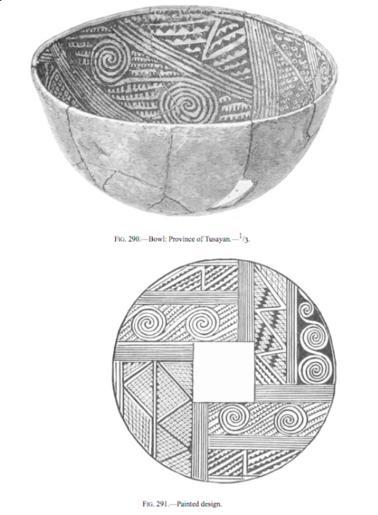MAKE A MEME
View Large Image

| View Original: | Tusayan_bowl.tiff (532x725) | |||
| Download: | Original | Medium | Small | Thumb |
| Courtesy of: | commons.wikimedia.org | More Like This | ||
| Keywords: Tusayan bowl.tiff en Fig 290 �Bowl Province of Tusayan The superb bowl presented in Fig 290 is nearly fifteen inches in diameter and seven inches deep It is hemispherical but not quite symmetrical Having been broken it was mended by its owners after their aboriginal fashion Two pairs of holes have been bored on opposite sides of a long fracture for the insertion of thongs Other perforations have been commenced but do not penetrate the vessel The walls are upwards of one-eighth of an inch in thickness near the rim but are less than that throughout the body of the bowl The paste is of a dark gray color speckled with ashy-white particles which may be pulverized potsherds The interior surface is finished with a slip of white clay 323 and has received a fair degree of polish The exterior is only trowel-finished and is much scarified by use The interior is embellished with a very elaborate design which is given with all possible accuracy in a plain projection in Fig 291 The work does not exhibit a great deal of skill or neatness in execution but the whole design is carefully made out and well adjusted to the deeply concave surface An analysis of this figure is easily given It is a cruciform arrangement of four portions of rather elaborate double borders Each part consists of two parallel 324 bands a principal and a subordinate separated by parallel lines and taking the relation to each other always noticed in the two belts of designs painted upon the exterior of vases Two of the sections are alike The others differ from these and from each other One figure consisting of three linked volutes is defined in white by painting around it a black ground The artist in painting this vessel has probably not thought of achieving anything beyond the filling up neatly of the four spaces and has followed the usual practice of borrowing his motives from other objects; yet it will not be wise to conclude that these figures are really meaningless combinations of lines The persistency and individuality of certain motives makes it almost certain that they are not the result of aimless elaboration and that the potter understood their significance They are too purely geometric however to furnish any clew to us through internal evidence We have no resource beyond the analogies of historic art Modern tribes use the current meander to symbolize water and a leading motive in many of these designs �the linked scroll running through a field of serrate lines �is wonderfully like some forms of the Aztec symbol for water as may be seen by reference to the Mexican codices http //www gutenberg org/files/41998/41998-h/41998-h htm p287_dp514 W H Holmes Pottery of the Ancient Pueblos ~ 1883 PD-Old Ancient pueblo people pottery Files uploaded by PDTillman 1880s documents 1880s art | ||||